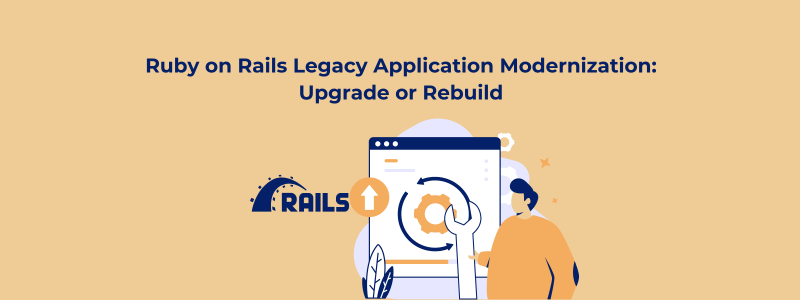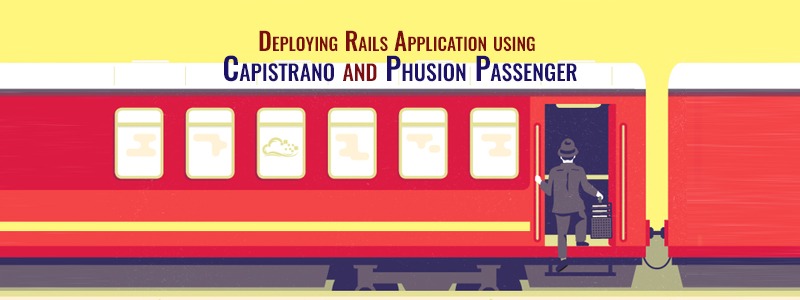Legacy applications are a common challenge for businesses striving to maintain a competitive edge in today’s fast-paced digital landscape. Over time, these applications can become outdated, inefficient, and difficult to maintain, hindering innovation and scalability. Ruby on Rails (RoR), a popular web development framework, often powers these legacy applications. When faced with the decision to modernize, businesses must choose between upgrading the existing application or rebuilding it from scratch. In this blog post, we’ll explore the considerations and implications of both approaches to help you make an informed decision.
Vad är Ruby on Rails?
Ruby on Rails, commonly referred to as Rails, is a popular open-source web application framework written in the Ruby programming language. It was created by David Heinemeier Hansson and released in 2004. Ruby on Rails follows the Model-View-Controller (MVC) architectural pattern, which separates an application into three interconnected components:
- Model: Represents the data and business logic of the application. It interacts with the database to perform CRUD (Create, Read, Update, Delete) operations.
- View: Handles the presentation layer of the application, generating the user interface based on the data provided by the controller.
- Controller: Acts as an intermediary between the model and the view, processing user requests, interacting with the model to retrieve or manipulate data, and rendering the appropriate view.
What are the Key Features of Ruby on Rails?
- Konvention över konfiguration (CoC):
Rails emphasizes sensible defaults and conventions, reducing the need for configuration and boilerplate code. Developers can follow established conventions, allowing for rapid development and consistency across projects.
- Upprepa inte dig själv (DRY):
Rails encourages writing reusable code and reducing redundancy. This principle promotes code efficiency and maintainability by minimizing duplication.
- ActiveRecord:
Rails includes ActiveRecord, an Object-Relational Mapping (ORM) library that simplifies database interactions by mapping database tables to Ruby objects. ActiveRecord provides an intuitive interface for querying, manipulating, and managing database records.
- Byggnadsställningar:
Rails provides scaffolding tools to generate boilerplate code for common tasks, such as creating models, controllers, and views. This feature accelerates development by automating repetitive tasks and providing a starting point for customization.
- Ädelstenar:
Rails leverages a vast ecosystem of libraries, known as gems, which provide additional functionality and features. Developers can easily integrate gems into their Rails applications to extend functionality, handle specific tasks, or streamline development.
- Integrated Testing Framework:
Rails comes with built-in support for testing, including tools for unit testing, integration testing, and system testing. This allows developers to write tests to ensure the correctness and reliability of their applications.
How Does Ruby on Rails Work?
Ruby on Rails (Rails) is a web application framework that follows the Model-View-Controller (MVC) architectural pattern. It works by providing a set of conventions, tools, and libraries to streamline the development of web applications in the Ruby programming language. Here’s how Rails typically works:
1. Routing:
- Rails uses a routing system to map incoming requests from the browser to the appropriate controller action.
- Routes are defined in the config/routes.rb file, where developers specify the URLs and corresponding controller actions.
2. Controller:
- When a request is received, Rails routes it to the appropriate controller based on the URL.
- Controllers are responsible for processing requests, interacting with models to retrieve or manipulate data, and rendering views.
- Controllers contain action methods that correspond to different HTTP verbs (e.g., index for handling GET requests, create for handling POST requests).
3. Model:
- Models represent the data and business logic of the application.
- In Rails, models are typically Ruby classes that interact with a database using an Object-Relational Mapping (ORM) library called ActiveRecord.
- ActiveRecord simplifies database operations by abstracting database tables as Ruby objects and providing methods for querying, creating, updating, and deleting records.
4. View:
- Views are responsible for presenting data to the user.
- In Rails, views are usually HTML templates with embedded Ruby code (ERB) that allows developers to dynamically generate HTML content based on data retrieved from the controller.
- Views are rendered by the controller and sent back to the browser as the response to the user’s request.
5. Assets:
- Rails provides a robust asset pipeline for managing JavaScript, CSS, and other assets.
- The asset pipeline processes and compiles assets, such as stylesheets and JavaScript files, to improve performance and organization.
- Developers can use asset helpers and preprocessors (e.g., Sass, CoffeeScript) to streamline asset management and enhance front-end development.
6. Middleware:
- Rails uses middleware to handle requests and responses at various stages of the request-response cycle.
- Middleware components can intercept requests, perform tasks like authentication or logging, and modify responses before they are sent back to the client.
- Middleware is configurable and can be added or removed based on application requirements.
7. Testing:
- Rails includes built-in support for testing, with tools for writing unit tests, integration tests, and system tests.
- Developers can use testing frameworks like MiniTest or RSpec to write automated tests to ensure the correctness and reliability of their applications.
- Testing is an integral part of the Rails development process and helps maintain application quality and stability.
Why is Ruby Great for Startups?
Ruby is a fantastic choice for startups for several reasons, which contribute to its popularity among entrepreneurs and developers alike. Here are some key reasons why Ruby is great for startups:
1. Rapid Development:
- Ruby’s elegant syntax and focus on developer productivity make it well-suited for rapid prototyping and iteration.
- With Ruby on Rails, startups can quickly build and launch Minimum Viable Products (MVPs) to validate ideas and gather feedback from users.
- Rails’ convention over configuration principle reduces the need for boilerplate code, allowing developers to focus on building features rather than dealing with configuration details.
2. Cost-Effectiveness:
- Ruby is an open-source language, meaning there are no licensing fees associated with its usage.
- Ruby on Rails’ productivity features, combined with the availability of a vast ecosystem of open-source libraries (gems), enable startups to build robust applications with minimal resources.
- Startups can find skilled Ruby developers at competitive rates, making it cost-effective to build and maintain Ruby on Rails-applikationer.
3. Scalability:
- Contrary to some misconceptions, Ruby on Rails is capable of scaling to support growing startups.
- Rails’ modular architecture and scalability features, such as caching, background processing, and database sharding, enable startups to scale their applications as their user base grows.
- Many successful startups, including Airbnb, GitHub, and Shopify, have built and scaled their platforms using Ruby on Rails.
4. Vibrant Community:
- Ruby has a vibrant and supportive community of developers, enthusiasts, and entrepreneurs.
- The Ruby community actively contributes to the ecosystem by creating gems, writing tutorials, organizing meetups, and providing support through forums and online communities.
- Startups can leverage the knowledge and resources available within the Ruby community to overcome challenges, learn best practices, and stay updated with the latest developments.
5. Developer Happiness:
- Ruby is known for its focus on developer happiness, emphasizing readability, simplicity, and expressiveness.
- Developers enjoy working with Ruby due to its clean syntax, powerful features, and flexibility.
- Happy developers are more productive and motivated, leading to faster development cycles and higher-quality code.
6. Ecosystem and Tools:
- Ruby on Rails comes with a robust ecosystem of tools and libraries, making it easy to handle common web development tasks such as authentication, database management, and testing.
- The availability of gems like Devise, ActiveAdmin, and FactoryBot accelerates development by providing ready-made solutions for various requirements.
- Additionally, tools like Bundler, Rake, and Capistrano streamline dependency management, task automation, and deployment processes.
Upgrade: Breathing New Life into Legacy Applications
Fördelar:
Kostnadseffektivt: Upgrading an existing Ruby on Rails application can be more cost-effective than rebuilding from scratch. By modernizing the existing codebase, businesses can leverage the existing infrastructure, data, and features, reducing the overall development time and cost.
Preserve Business Logic and Data: Upgrading allows businesses to retain valuable business logic, data, and user interfaces. This approach minimizes the risk of data loss and ensures continuity for end-users.
Incremental Improvements: With the upgrade approach, businesses can adopt a phased approach to modernization. This incremental process allows for continuous improvements, reducing downtime and business disruption.
Challenges:
Technical Debt: Legacy codebases often accumulate technical debt over time, making upgrades challenging and error-prone. Addressing technical debt requires thorough code reviews, refactoring, and testing to ensure stability and performance.
Compatibility Issues: Upgrading a legacy application may lead to compatibility issues with newer libraries, gems, or third-party services. This can require additional effort to resolve dependencies and ensure seamless integration.
Limited Scope for Innovation: While upgrading can extend the life of a legacy application, it may still lack the modern architecture and features required to support innovative business initiatives and scale effectively.
Rebuild: Embracing Modernization for Long-Term Success
Fördelar:
Modern Architecture: Rebuilding a Ruby on Rails application allows businesses to adopt modern architectural patterns, technologies, and best practices. This approach can enhance scalability, performance, and maintainability.
Clean Codebase: Starting from scratch enables developers to write clean, well-organized code, reducing technical debt and improving code maintainability. This can accelerate future development efforts and reduce the risk of errors.
Innovation and Flexibility: Rebuilding provides businesses with the opportunity to innovate and introduce new features, workflows, and integrations that align with current market trends and customer demands.
Challenges:
Time and Cost: Rebuilding a Ruby on Rails application is a time-consuming and resource-intensive process. It requires careful planning, design, and development, which can increase the initial investment and time-to-market.
Data Migration: Transferring data from the old system to the new one can be complex and error-prone. Ensuring data integrity, consistency, and security during migration requires meticulous planning and execution.
Business Disruption: Rebuilding an application can disrupt business operations, affecting employees, customers, and stakeholders. Proper communication, planning, and implementation strategies are essential to minimize downtime and ensure a smooth transition.
How To Give A Green Light To Your Project With RailsCarma?
Giving a green light to your project with RailsCarma involves several key steps to ensure a successful collaboration and project delivery. RailsCarma is a leading technology solutions provider known for its expertise in web development, utveckling av mobilappar, digital transformation, and IT consulting. Here’s how you can initiate and kickstart your project with RailsCarma:
1. Define Your Project Goals:
- Clearly define the objectives, scope, and requirements of your project. Outline the desired outcomes, target audience, and key features or functionalities you wish to include.
- Consider factors such as timeline, budget, and resource allocation to ensure alignment with your business goals and constraints.
2. Consultation and Discovery:
- Schedule a consultation with RailsCarma’s team of experts to discuss your project vision, goals, and requirements in detail.
- During the discovery phase, RailsCarma’s team will conduct thorough research and analysis to understand your business, industry, competitors, and target audience.
- Collaborate with RailsCarma’s consultants to refine your project scope, identify potential challenges, and explore innovative solutions.
3. Proposal and Agreement:
- Once the project scope is defined, RailsCarma will prepare a detailed proposal outlining the project scope, deliverables, timeline, cost estimates, and terms of engagement.
- Review the proposal carefully and discuss any clarifications or modifications with RailsCarma’s team.
- Upon agreement, sign the contract or engagement letter to formalize the partnership and initiate the project.
4. Project Kickoff:
- With the agreement in place, RailsCarma will assemble a dedicated project team comprising designers, developers, project managers, and other specialists as required.
- Schedule a project kickoff meeting to introduce key stakeholders, establish communication channels, and align on project expectations, roles, and responsibilities.
- Define project milestones, deliverables, and timelines to track progress and ensure timely delivery.
5. Agile Development and Collaboration:
- RailsCarma follows Agile methodologies such as Scrum or Kanban to facilitate iterative development and continuous improvement.
- Participate actively in regular project meetings, demos, and reviews to provide feedback, prioritize tasks, and make informed decisions.
- Foster open communication and collaboration with RailsCarma’s team to address any challenges or changes effectively.
6. Quality Assurance and Testing:
- RailsCarma prioritizes quality assurance and testing throughout the development lifecycle to ensure the reliability, performance, and security of your project.
- Conduct thorough testing, including functional testing, user acceptance testing (UAT), and performance testing, to validate the functionality and usability of the solution.
7. Deployment and Launch:
- Once the development and testing phases are complete, collaborate with RailsCarma’s team to deploy the solution to the production environment.
- Ensure proper documentation, training, and support materials are provided to end-users to facilitate a smooth transition and adoption of the solution.
- Celebrate the successful launch of your project with RailsCarma and monitor its performance and user feedback to drive ongoing improvements and enhancements.
Conclusion: Upgrade or Rebuild?
Deciding between upgrading or rebuilding a Ruby on Rails legacy application depends on various factors, including the application’s complexity, technical debt, business requirements, and long-term goals. Upgrade is suitable for applications with valuable business logic and data that require incremental improvements to extend their lifespan and maintain continuity.
Rebuild is recommended for applications that have significant technical debt, scalability issues, and lack modern features and architecture. This approach offers a fresh start to embrace innovation, scalability, and long-term success.
Regardless of the chosen approach, partnering with experienced Ruby on Rails developers and following best practices for modernization can help businesses navigate the complexities of legacy application modernization effectively.
Modernizing a Ruby on Rails legacy application is a strategic investment that can unlock new opportunities, enhance user experiences, and drive business growth in today’s competitive digital landscape. Whether you choose to upgrade or rebuild, prioritizing modernization is crucial for staying ahead and delivering value to your customers. To know more connect with RailsCarma.









